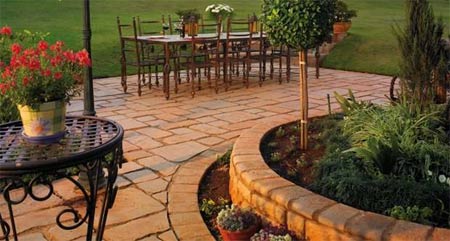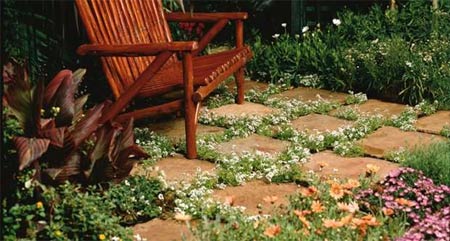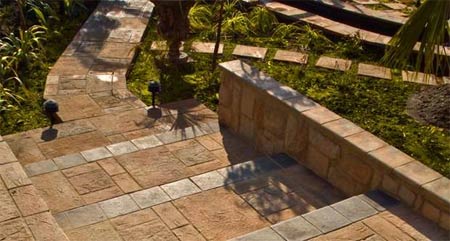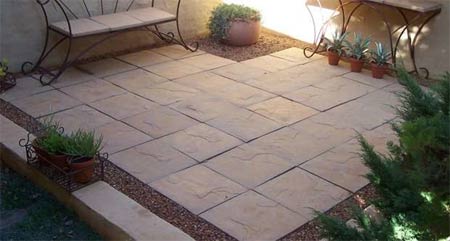Paving ideas for a home
Just as your home makes a statement about who you are and what you value, so do the patios, walkways and driveways that connect your home to the outside world.
Brick pavers are a building material made from natural clay or concrete. Clay bricks, also used for paving, are fired in a kiln to remove any excess moisture, leaving them very hard and dense. The concrete pavers are made out of sand, stone and cement and put into moulds under pressure, which also makes them very strong and hard wearing. Both materials are ideal for outdoor paving applications – both have their strengths and weaknesses, and both can be used in all sorts of applications.
Types of pavers
Most paving bricks can be categorised as either interlocking or standard.
Clay bricks are generally standard, while the cement options can be standard or interlocking. Interlocking pavers are designed to interconnect with one another to minimise movement.
They are usually laid on a compacted bed of river sand, without the need for mortar. This speeds up the installation process and offers an end result that is resistant to cracks as these pavers are built accommodate most ground movement. The standard brick needs to be installed with mortar to keep it firmly in place.
Clay pavers
Clay pavers have a timeless appeal that imparts an image of classic elegance to both older and ultra-modern homes. Clay paving bricks are very hard and nonporous.
An all-natural product, they give off a warm, appealing look that is popular amongst many homeowners.
Clay bricks also work very well around the swimming pool, as they are relatively rough and hence offer great traction and slip-resistance when wet.
The one drawback with clay pavers is the fact that there is a rather limited choice of colours to choose from – the natural red, orange and brown hues go well with most homes, but if you want something completely different, it is probably best to choose cement or concrete pavers instead.
Cement and concrete pavers
Concrete pavers, which may appear similar to their clay counterparts, are actually a very different product. These types of pavers are a versatile floor covering – not only do they come in hundreds of different colours, but they are also available in an exceptionally wide range of shapes and sizes too.
No matter what the style and colour of your home, you will find a cement paver to match. If you have looked at most commercial premises, you will notice the interlocking cement bricks are used for both pathways, pavements and parking areas, as they are an exceptionally strong and durable option.
Stone is among the most nuanced and luxurious of paving materials. It’s also durable and versatile, offering an enormous range of colours, shapes, and sizes. From irregularly shaped flagstones for country-garden paths to precision-cut geometric blocks for a formal patio, there is a stone for every garden situation. All of this, however, comes at a price. Stone can be expensive to purchase and install.
There are a few points to keep in mind when purchasing stone for paving. A thickness of at least 4cm is best for supporting frequent foot traffic and enduring the vagaries of settling or weather. Avoid rounded cobblestones, and flagstones with a polished or honed finish, which can be hard on the ankles and slick when wet. Instead, choose stones that are flat and have a natural-cleft surface and offer some grip or texture.
Before making a costly commitment to any material, check its colour when wet. That pretty honey-tan granite you like so much could turn a lurid golden orange in the rain. Likewise, a subtle pattern in your sandstone may become objectionably bold when accentuated by moisture.
Making your decision
Whatever paver you choose, make sure that it compliments the architectural style and colour of your home, as well as the landscape in which it is to be featured – there is a plethora of various colours, shapes and sizes to choose from, as well as a number of various formats and designs in which they can be laid.
A good idea is to take a few samples of different pavers back with you, lay them in your driveway, stand back and see which works best from an aesthetic point of view. The contractor chosen to install the pavers should also be a wealth of knowledge and should be able to offer some good insights, tips and advice.
The installation process
Paving should be left to the professionals for optimum results. It is advisable that you personally monitor the installation process to ensure that the area is levelled correctly – so often, the installation professionals do not level the area perfectly and you can end up with pools of water on your patio, pathways or in your driveway.
Speak to the installation team and ask them how they plan to level the ground to ensure this does not happen. This is very important, because if the area slopes the wrong way, after a big storm, you can end up with the water running directly into your home or garage. If paving is well installed, it should last a lifetime.
Small garden - small budget
Gravel is easy to install and provides an attractive texture ideal for informal landscapes, short-term paving solutions, and gardens built on limited budgets. The objections usually raised against gravel is that it can become weedy and it’s too unstable underfoot. Weeds can become a problem if gravel is left untended, so it’s best to stay on top of them.
Images provided by Smart Stone




